THURSDAY
AUGUST 30 - 2018
Hornet
on Brook Meadow
I had a stroll
around the meadow on a lovely warm autumnal afternoon.
Lots of insects were feeding on the open flowers of
Common Fleabane, Wild Angelica, Hoary Ragwort and
others. From its large size what must have been a
Hornet caught my attention as it flew rapidly over the
Lumley area, seemingly looking for prey. It dropped
into the vegetation where I managed to get a few
photos of it apparently struggling with some
unfortunate creature that it had caught. It is not
easy to see what is going on from the tangle of legs
and wings, but I suspect the victim was a Bumblebee.
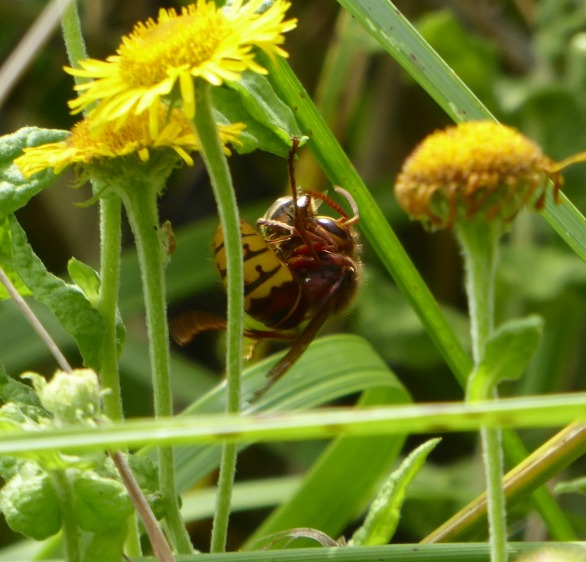
Cattle
Egrets on the way?
As Cattle
Egrets sometimes turn up in our area, notably at
Warblington Farm, Ralph Hollins thought we might be
interested to know that on Aug 28 there was a record
flock of 51 at South Huish Marsh near Salcombe at the
southern tip of Devon. See Aug 28 entry on . . .
https://www.devonbirds.org/news/bird_news/devon_bird_sightings
That report says that they then headed NE towards our
area!!
There was a Cattle Egret at Warblington last winter
which was tracked by Peter Milinets-Raby among many
others. Here is a photo Peter got of this bird perched
in a tree on 15-Nov-17.
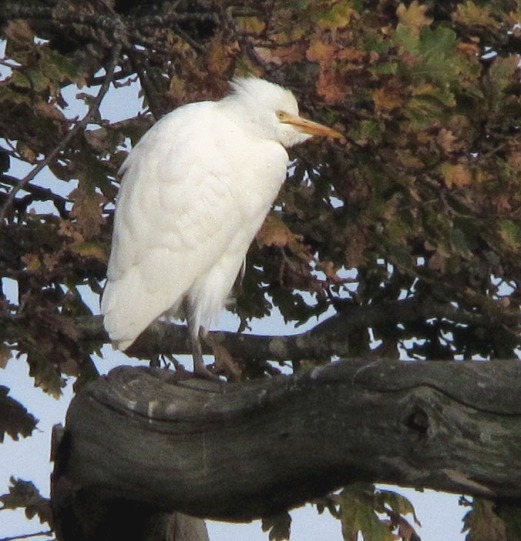
WEDNESDAY
AUGUST 29 - 2018
Emsworth
to Warblington
After the rain
passed through Peter Milinets-Raby wandered along the
shore from Emsworth to Warblington (9:48am to
12:11pm).
Emsworth
Beacon Square
1 Greenshank, 60+ Swallow and 30+ Sand Martin milling
about over the marsh. 1 Common Gull, 11 eclipse Teal,
Male Blackcap in back garden, 1 Turnstone.
Nore Barn.
3 Greenshank (YO//- + YY//-). 20+ Swallow with 10+
Sand Martin perched on a yacht. 2 Shelduck.
Emsworth Harbour
6 Grey Plover, 12 Black tailed Godwit, 4 Swallow and 7
Sand Martin, 8 Mute Swan, 4 Greenshank, 7 Turnstone, 2
eclipse Teal.
Warblington
Ibis Field. 31 Collared Dove on wires, 1
Sparrowhawk.
Conigar Point
13 Grey Plover, 21 Dunlin, 6 Lesser Black-backed Gull,
1 Wheatear dashed across the shore and promptly
vanished.
SSSI Field, 1 Whitethroat, 1 Buzzard
Off Pook Lane
1 Whitethroat in the hedge. 9 Greenshank.
A truly amazing count of 381 Black tailed Godwit
roosting on the shore adjacent to the pub as the
tide pushed in - this is the most I have ever seen in
the Emsworth /Warblington area!!
Peter counted the Little Egrets coming in to the
Langstone Mill Pond roost this evening between 6::55pm
and 8:25pm. Poor numbers - only 136 little Egrets came
into roost.
TUESDAY
AUGUST 28 - 2018
Langstone
Mill Pond
Peter
Milinets-Raby had a visit to Langstone Mill Pond late
morning ahead of the tide coming in (10:24am to
11:48am)
On the pond: 35 Little Egrets loitering after staying
the night, 63 Mallard, 2 eclipse female Shoveler, 1
female type Tufted Duck, 9 female eclipse Teal, 1
Little Grebe, 2 Stock Dove.
Off shore: 114 Black-tailed Godwit (O//R + N//G), 141
Redshank ( B//NN & B//NG), 1 Juvenile Common
Sandpiper very briefly in the outflow stream before
flying off.
3 Greenshank, 10 Common Gull, 2 Grey Plover, 7 Dunlin,
5 Mute Swan, 1 Swallow.
Off Conigar Point: 15 Grey Plover. 1
Greenshank.
MONDAY
AUGUST 27 - 2018
Emsworth
Show
The Brook
Meadow Conservation Group has their usual stall at the
Emsworth Show today. After dreadful weather yesterday,
today turned out fine and remarkably dry underfoot.
Several volunteers led by Jennifer Rye set up the
stall by 10am. The day was a great success with a
steady flow of visitors.
Here is David all
ready for customers!

I arrived as usual
with my bike basket crammed with wild flowers and
berries picked this morning from Brook Meadow.

For Jennifer's full
report together with more photos go to . . .
https://www.brookmeadow.org.uk/
SATURDAY
AUGUST 25 - 2018
Red
Cage Fungus
Regarding the
Red Cage fungus reported in last night night's blog,
Ralph Hollins thinks it is well worth keeping our eyes
open during the coming autumn for local occurrences of
this unusual fungus which has been reported from a
garden in Cosham, from four locations in Hampshire,
and from Durlston in Dorset, since 2015. Ralph
suspects that it occurs more widely but hidden under
vegetation as the fungi uses flies to spread their
spores and do not need to be in an exposed site where
the wind can spread the spores.
In addition Ralph supplied several useful links to
follow up. For a photo of a mature specimen covered
with flies see . . . http://ih1.redbubble.net/image.9703116.4122/flat,550x550,075,f.jpg
The fungus is about 10
cm long and only acquires its red colour (initially
whitish), and attracts flies, when ready to spread its
spores. The four Hampshire locations (including one in
Southsea) are mapped by the Hampshire Fungus Recording
Group http://www.hampshirefungi.org.uk/
The map can be accessed directly at http://www.hampshirefungi.org.uk/fungi.php?name=Clathrus+ruber
- To see national records click FRDBI to the left of
the Hampshire map. Interestingly, this fungus is
relatively common on the IoW.
Wheatears
at Prinsted
Sue Thomas
walked along the sea wall at Prinstead this morning
where she saw 3 Wheatears...one on the rocky shore,
one on the beach and another in the fields. Here is a
picture of the one in the field. Sue apologises for
the poor quality photo, but her camera was playing up
at the time.

Wheatears move through
our area on passage from their breeding grounds
further north to their wintering quarters in tropical
Africa, south of the Sahara. The seawall between
Prinsted and Nutbourne is one of the best places
locally to see these sprightly birds, in spring and
autumn. Very few breed locally and hardly any spend
the winter here.
Sue also saw this
swan family with 6 cygnets. Where did they come
from?
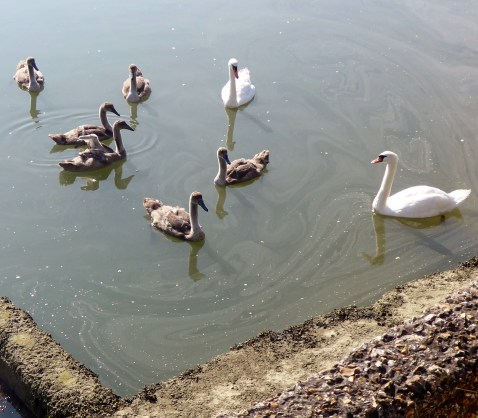
FRIDAY
AUGUST 24 - 2018
Cuban
fungus
Malcolm
Phillips sent me the following photo of an attractive
bright red fungus that emerged in his garden after
rain in Cuba where he now lives.
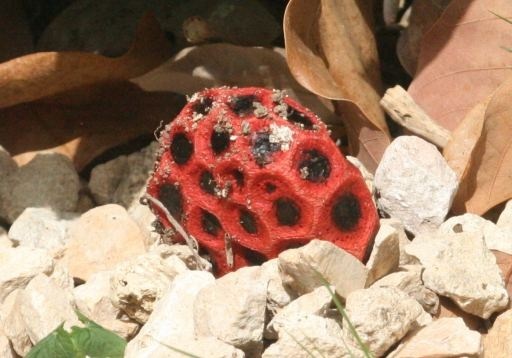
I did not expect to
find it in my British fungus guide, but it was there -
named as Clathrus ruber. It is a
saprobic fungus in the Stinkhorn family, feeding off
decaying woody plant material, often found alone or in
groups in leaf litter on garden soil, grassy places,
or on woodchip garden mulches and is similarly foul
smelling. It has various common names, including Cage
Fungus, Red Cage, Latticed Stinkhorn and Basket
Stinkhorn. If you do happen to come across it in this
country I would like to hear about it.
Although considered
primarily a European species, C. ruber has been
introduced to other areas, and now has a wide
distribution that includes northern Africa, Asia,
Australia, North and South America and also Cuba
(thanks to Malcolm). Apparently, it is rare in
mainland Britain but fairly common in the Channel
Islands.
THURSDAY
AUGUST 23 - 2018
Camberwell
Beauty?
Ralph Hollins
is fairly sure that the photo of a large brown
butterfly taken by Roger Clark was not a Camberwell
Beauty. See blog entry for Aug 21. Checking on the
internet confirmed that both male and female
Camberwell Beauty differ markedly from Roger's photo.
See . . . . https://www.ukbutterflies.co.uk/species.php?species=antiopa
Roger's
original photo on left and genuine Camberwell Beauty
on right
Ralph added that this
was probably a further instance of the growing trade
in selling butterflies for release at weddings,
funerals and other social occasions. Googling
'Butterflies for weddings' brings up several links to
several websites doing just this. Butterfly
Conservation strongly deplores the practice of
breeding butterflies for release into an environment
in which they are doomed to an early death while at
the same time confusing genuine surveys. See . . .
https://butterfly-conservation.org/news-and-blog/releasing-butterflies-at-weddings
WEDNESDAY
AUGUST 22 - 2018
Emsworth
Harbour
Peter
Milinets-Raby had a wander along the Emsworth shore
from Beacon Square, to Nore Barn and along the
Emsworth Mill Pond - Noon to 1:48pm tide dropping. The
highlights were as follows:
Beacon Square: 1 Coal Tit in back gardens, 2 Linnets
over, 1 Greenshank, 3 Lesser Black-backed Gulls, 4
Grey Plover, 1 Dunlin.
Nore Barn: 6 Mute Swan, 31 Black-tailed Godwit, 100+
Redshank + G//OG + G//YB + B//WR + O//BN, 3
Greenshank, 1 Whimbrel.
Emsworth Harbour: 16 Greenshank - an amazing
sight, 18 Black-tailed Godwit, 20 Turnstone, 1 Dunlin,
1 Grey Plover, 1 Great Black-backed Gull.
Godwits
'spurting' and 'bubbling'!
On Monday (Aug
20) Chris Cockburn was taking random photos of
Black-tailed Godwits feeding in the HCC Marsh Field
from the Hayling Billy Trail north. He says it had to
be 'random' because of his AMD vision problem.
The Godwits were frantically feeding on what Chris
thinks were Hydrobia species whilst
standing in water approximately up to their leg
length, thereby necessitating deep probing with their
bills. Interestingly, Chris captured one Black-tailed
Godwit spurting water from its bill.

'Spurting' behaviour
in Black-tailed Godwits and other waders was a topic
that interested me several years ago. In addition to
Black-tailed Godwits I also have observed Greenshank,
Spotted Redshank, Common Redshank and even Spoonbill
'spurting'.
I consulted various Godwit experts, none of whom had
ever seen or heard of it, or knew why it should
happen. Pete Potts suggested I should send the photos
to Dr Humphrey Sitters, Editor of the Wader Study
Group Bulletin, who sent them on to international
wader authorities who likewise did not know anything
about it either. Eventually, I was asked to write a
paper which was published in this learned
ornithological publication.
You can see my sightings, photos and discussion of its
function on a special page on this web site at . . .
Spurting
behaviour
Today Chris got
another photo of a Black-tailed Godwit this time
apparently squirting air or water below the water
level creating bubbles. Chris thinks this might be a
behaviour to move soft mud and expose
Hydrobia sp (or other small prey items).
I don't recall having seen this bubbling behaviour.
Does anyone else have observations and photos of this
unusual behaviour?
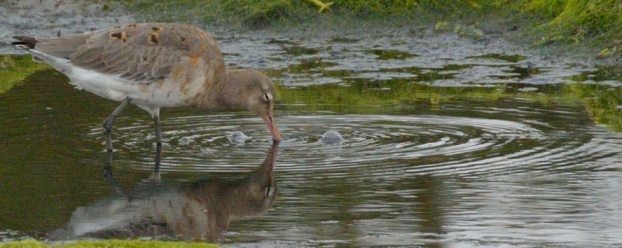
TUESDAY
AUGUST 21 - 2018
Camberwell
Beauty?
Roger Clark
sent me a photo of a large and impressive butterfly,
two of which he came across on Brook Meadow yesterday
while he was on his way to Tesco's ! Two for the price
of one?
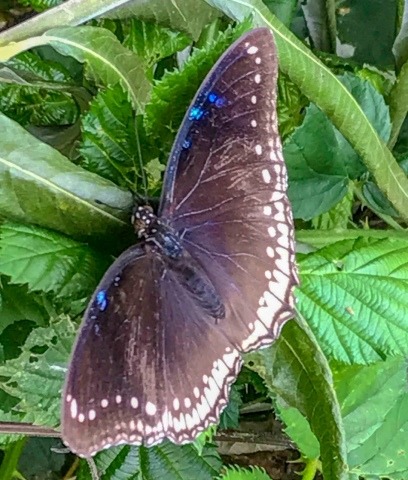
Roger wondered if it
could be a Camberwell Beauty. It certainly looks like
it, though there are some differences from the
illustrations in the field guides especially the
absence of the blue spots around the edges of the
wings.
Camberwell Beauty is a
very rare butterfly in this country and sightings tend
to be in Eastern England and Scotland. It breeds in
Scandinavia and occasionally migrates across to the
UK. Sometimes there are major invasions, like in Aug
1995, when Camberwell Beauties were seen in the South
of England, but generally they are rarely seen down
here.
A big problem with the acceptance of sightings of
Camberwell Beauty in this country is that it is
popular with breeders and butterfly farms. Hence, odd
sightings like Roger's may not be genuine migrants,
but escapes or releases.
Roger consulted Steven Cheshire (at
britishbutterflies.co.uk) who thought the butterfly
was an escapee from a local butterfly house of which
there are one or two in our area. In fact, Steven
doubted that Roger's butterfly was in fact a
Camberwell Beauty at all.
My only other
Camberwell Beauty in my records locally is of one seen
and photographed by a lady in her garden at Compton in
Sep 2006. I am not sure what was decided about the
genuineness or otherwise of this insect, but it looks
a good one, with the blue spots in place. So please
would everyone please keep a look out for these
magnificent butterflies - while on your way to Tesco's
or elsewhere!
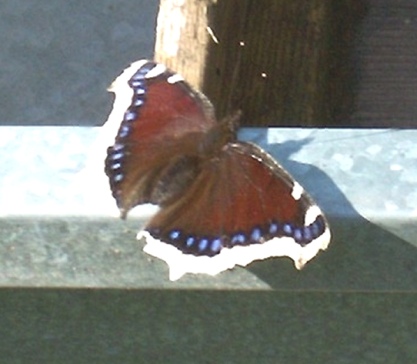
I have suggested to
Roger that he should submit his sighting with the
photo to Hants Butterfly Conservation for their
verdict. After all, this is the right time of the year
to see these amazing butterflies and genuine migrants
are not out of the question. I note there are no other
sightings of Camberwell Beauty on the Hants butterfly
site, though the Sussex site does have two records for
this year: 18 July and 23 June. The submission form is
here . . . http://hantsiow-butterflies.org.uk/news_form.php
Apparently, the name
Camberwell Beauty comes from the fact that the
butterfly was first seen in Cool Arbour Lane (now
Coldharbour Lane), Camberwell, London in 1748. It was
recorded in the 1766 publication 'The Aurelian' as
"The Grand Surprise" or "Camberwell Beauty". Its other
names include the Mourning Cloak, White Petticoat and
Willow Beauty.
MONDAY
AUGUST 20 - 2018
Waysides
News
I had a walk
around the local waysides this morning starting at
Washington Road. The Greater Burdock near the
entrance to the Recreation Ground have finished
flowering, but have done well. I counted a total of 58
plants which is a record for this site and certainly
the best crop of Greater Burdock in the local area
where Lesser Burdock is far more common. It seems that
the hard mowing they received from the Norse cutters
last year did them no harm! So much for the no-cut
waysides philosophy!
Here is a view
looking towards the recreation ground.
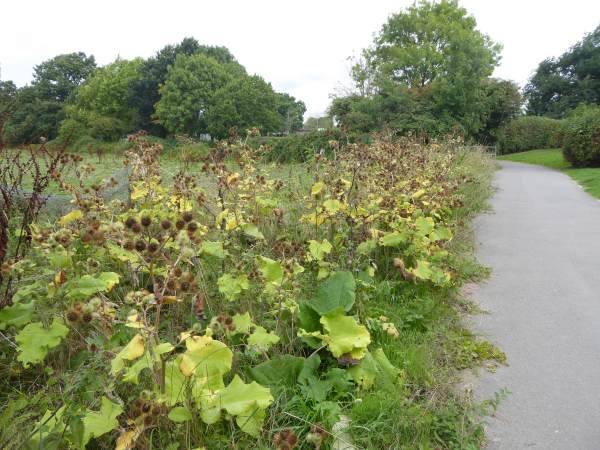
Here is a close up of
one of the plants showing the characteristic
clustering of flowerheads at the top of the stems. In
Lesser Burdock they tend to be arranged sequentially
up the stem.
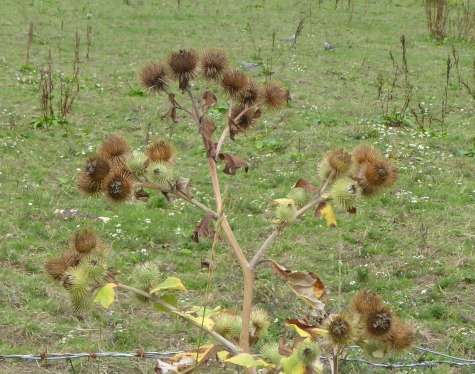
I discovered another
Greater Burdock plant along the track to the metal
gate on the Horndean Road.
Walking across the
mown area of the recreation ground north of the
bowling club, I stopped to inspect some of clumps of
what I think are Lesser Hawkbit scattered
attractively across the grassland. Each plant consists
of several solitary bright yellow 'daisy-like' flowers
on delicate leafless and unbranched stems arising from
a rosette of lobed leaves. Looked at closely the hairs
on the leaves are forked, as they are in Rough
Hawkbit, but Lesser Hawkbit is much less hairy than
Hairy Hawkbit.
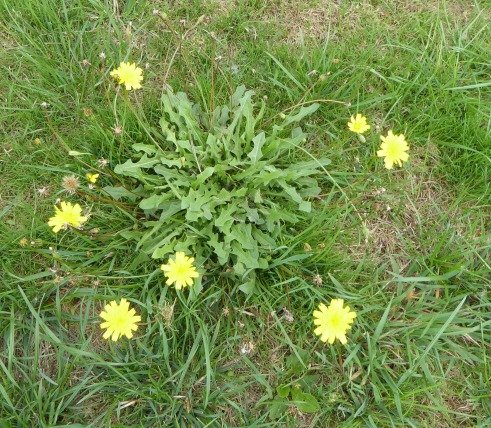
I made my across to
Christopher Way where I found flowers on Wild
Clary plants on the council mown grass verge at
the north end of the road. Wild Clary does tend to
keep flowering late in the season.
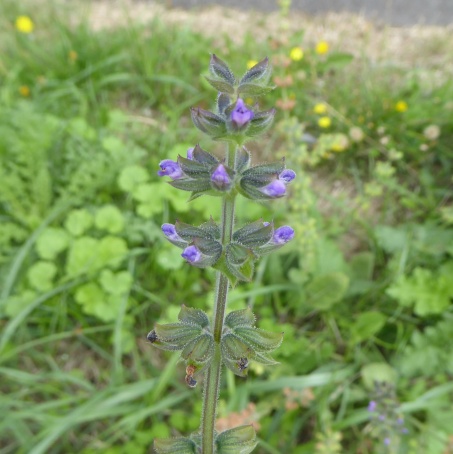
Coming south along
Horndean Road I came across a good flowering of
Redshank on the edge of the road.

I had a quick look at
the wayside north of Emsworth Railway Station from the
access ramp. It was a riot of colour with masses of
fading wild flowers. In particular, I love the mixture
of pink flowers and fluffy tangled seedheads of
Great Willowherb. This clump of Goldenrod
also caught my attention.
Finally, I noted
several examples of Conyza species growing in the
cracks in the pavement in Victoria Road. The leaves
were edged with hooked hairs, so they are probably
Guernsey Fleabane (Conyza
sumatrensis).
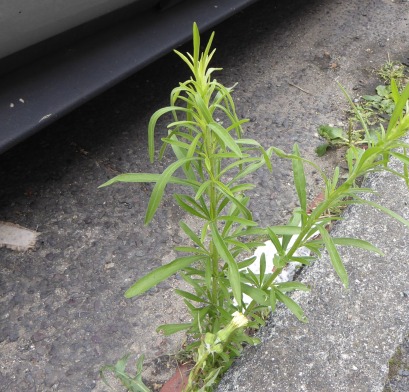
SUNDAY
AUGUST 19 - 2018
Brook
Meadow
Not a lot to
report from my stroll around Brook Meadow this
afternoon.
What looks like a Conyza species Fleabane
(probably Guernsey Fleabane) is growing on the north
meadow where the volunteers have cleared what they
call a 'play area'. I will keep an eye on it. The
leaves appear to have the required small hooks along
their edges.
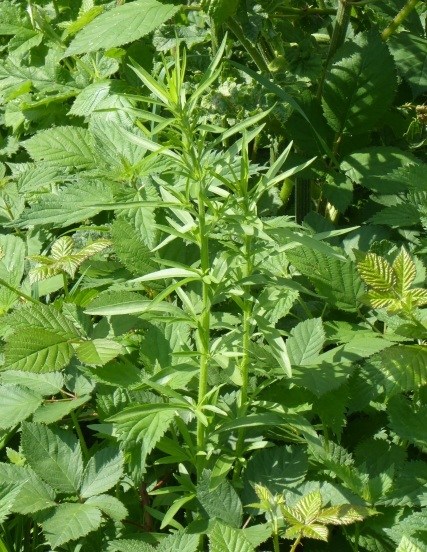
While on the orchid
area I spotted a female Common Darter which
perched conveniently for a photo an old Yellow Rattle
plant with spent seed capsules.
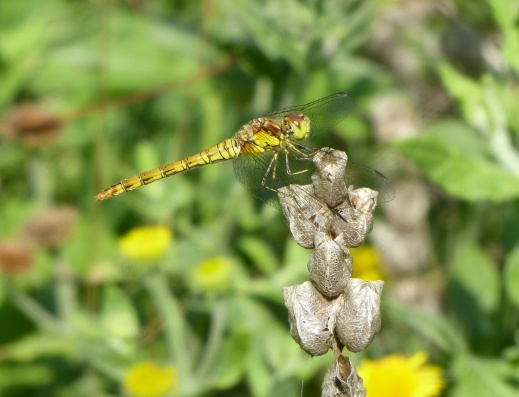
Lots of other insects
were feeding on the meadow flowers, including several
Honey Bees on the Common Fleabane with bulging
orange coloured pollen sacs and hoverflies -
the one on the right below is a Myothropa
florea hoverfly with a distinctively marked
thorax.
The Lumley area is a
glorious mixture of flowers in various stages of
development and decay. Of the newer ones, Water
Mint is flowering well along with a very good crop
of over 20 plants of Pepper-saxifrage.
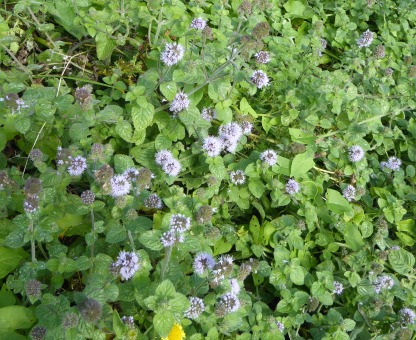
Sadly, the Strawberry
Clover plants along the edge of the eastern path
around the Lumley area have been victims yet again of
inadvertent mowing by the conservation group before
they reached maturity. That's a pity, but they always
come bouncing back.
Down onto the south meadow I was pleased to see the
pretty flower spikes of Marsh Woundwort still
looking good and attracting insects near the Weeping
Willow.
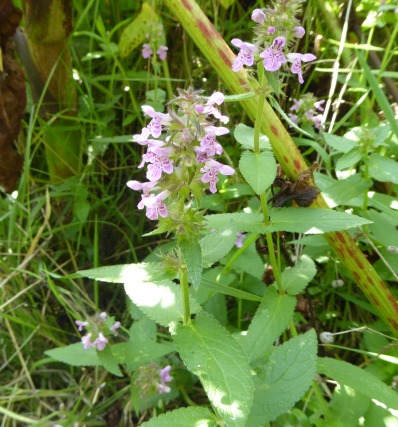
Something seems to
have got at the Horse Chestnut near the Weeping Willow
- more than leaf miner damage I think. The vegetation
in the south meadow is dominated as usual by a large
crop of Wild Angelica.
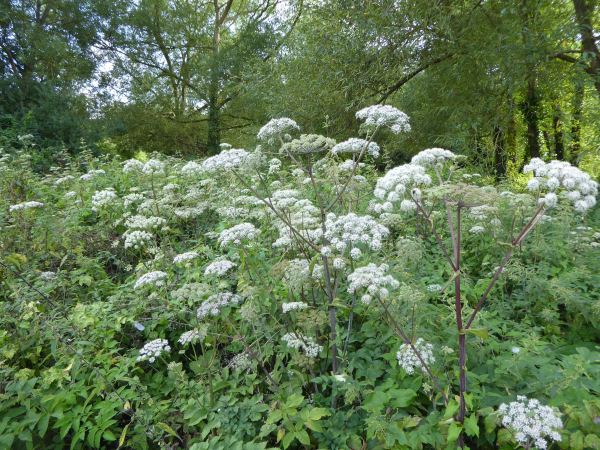
Old
Winchester Hill
The Friends of
Wildlife group visited Old Winchester Hill yesterday
and got some terrific photos as show below. Heather's
full report can be seen on the page at . . . .
Havant
Wildlife Group
Herdwick
sheep.
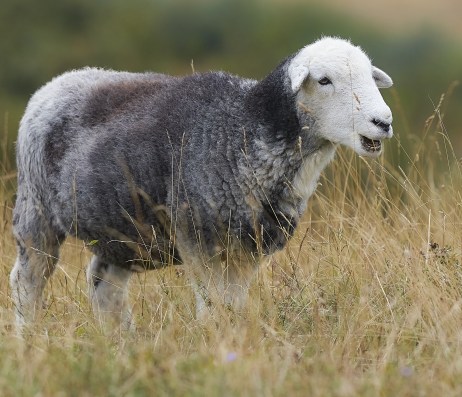
Silver spotted
Skippers - upper and under wings
All the usual chalk
downland wild plants especially the Round Headed
Rampion,
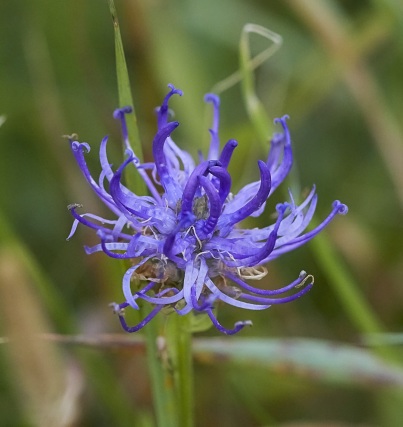
Red Kite

SATURDAY
AUGUST 18 - 2018
Cardinal
Beetle - correction
I have heard
from entomologist Bryan Pinchen who thinks the
Cardinal Beetle in last night's blog is the
Net-winged Beetle (Platycis
minutus). It is a smaller species than the
cardinals, and has heavily dimpled/wrinkled wing
cases, the head and pronotum/thorax are dark to black,
and the black antennae are tipped with orange (all of
which can be seen in the photo).
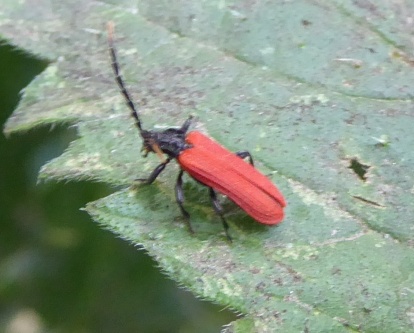
The Net-winged Beetle
is classified as a Nationally Scarce 'B' species, and
found in old woodland. Bryan added, "In my experience
of the species I tend to find it more at this time of
year until the end of the month, than at any other
time of the year. It is sometimes said to favour areas
with old Beech, but I've found it on sites with no
Beech for many miles. A nice thing to
find."
Warblington
shore
Peter
Milinets-Raby had a couple of visits to the
Warblington shore - Today and yesterday - low
tide.
Conigar Point: 1 Swift (probably the last I shall see
this summer??). 6 Lesser Black-backed Gulls - 3 adults
with 3 juvs. 1 Greenshank. 1 female/eclipse Teal. 1
Lapwing. Yesterday: 6 Canada Geese
Off Pook Lane: 22 Grey Plover - 3 in winter plumage.
19 Dunlin. 4 Greenshank (G//R + WY//- G//R + BR//-). 9
Ringed Plover. 8 Black-tailed Godwit. 1 Meadow Pipit
over
Yesterday: An amazing 12 Greenshank (RG//- + YY//-). 1
Whimbrel. 138 Redshank ( + B//YG + B//BB + B//WY +
B//NO + B//NB). 102 Black-tailed Godwit
Teal - female/eclipse type (see photo) on Langstone
Mill Pond with 73 Mallard.

Also the sea wall
along the Warblington shore has been repaired with a
tough flexible, but hard material - probably a form of
fibreglass???

FRIDAY
AUGUST 17 - 2018
Nore
Barn
I had a walk
round Nore Barn this morning hoping I might see the
Wall Brown that Brian Lawrence had there two days ago.
I had a nice walk round and through the woods, but
there was no sign of the Wall. However, I did have a
rather sweet summer brood male Small White feeding on
Golden Samphire.
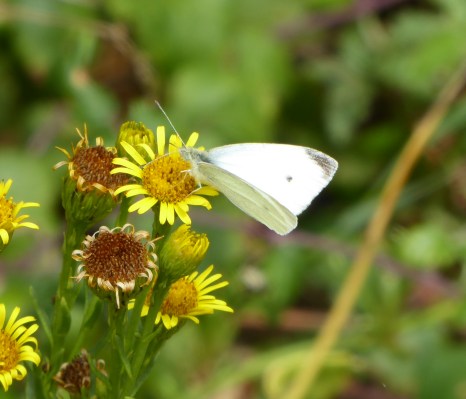
I brought home a few
stems of aromatic Sea Wormwood for my desk -
there was the usual large patch growing on the western
saltmarshes

Glasswort was looking
fresh on the saltmarshes and Sea Aster coming into
flower.
Cardinal
Beetle
I spotted this
bright red Cardinal Beetle resting a leaf in rhe
middle of Nore Barn Woods.
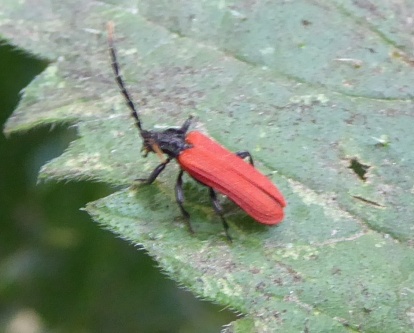
There are three
species of Cardinal Beetle.
1. The Red-headed or Common Cardinal Beetle is red to
orange with a red head.
2. The rarer Black-headed Cardinal Beetle is slightly
larger than the Red-headed with brighter colouring,
but has a black head.
3. The Scarce Cardinal Beetle also has a black head,
but is smaller and only found in a few sites in
Scotland and Wales.
So this one is almost certainly a Black-headed
Cardinal Beetle (Pyrochroa
coccinea).
Wall
Brown decline
Spurred by
news of Brian Lawrence's Wall Brown sighting, and
having seen fewer examples of this butterfly than
expected, Ralph Hollins Googled the status of the
species and came up with this interesting newspaper
article describing its decline due to climate change.
See . . . https://www.theguardian.com/environment/2014/dec/24/wall-brown-butterfly-may-be-a-victim-of-climate-change
THURSDAY
AUGUST 16 - 2018
Brook
Meadow - Work session
It was raining
quite heavily when I left the house to walk up to the
meadow for the regular 3rd Thursday in the month work
session. Despite the inclement weather, there was a
fair turn out of nine volunteers.
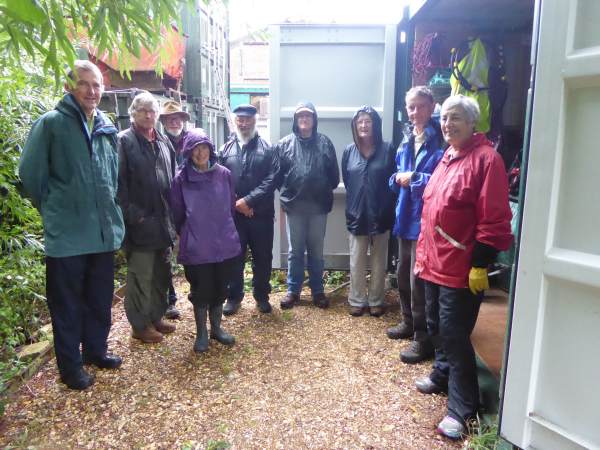
The session was led by
Colin Brotherston who outlined the tasks for the day
which included cutting back the main paths with the
power scythe, trimming off branches over the signcases
and repositioning piles of twigs. I went around taking
photos, trying to keep rain off the camera, but
gradually getting very wet. Colin called a halt to the
work at the coffee break.
For the full report of
the work session and more photos go to . . .
https://www.brookmeadow.org.uk/conservation-news/
Wildlife
observations
I spotted a
small bug resting on a panicle of Timothy grass. It
looks like a Tortoise Shieldbug
(Eurygaster testudinaria) though I would
not be 100% certain.
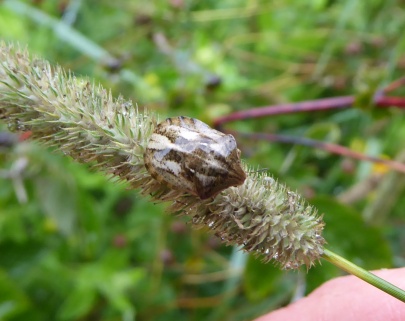
The Rowan plantation
on the east side of the north meadow is a glorious
picture of red berries. I don't recall ever having
seen such a good showing of berries on the 20 trees
which were planted in 2005 in memory of Gwynne
Johnson. Plenty of nourishing food for the local
Blackbirds and leaving some hopefully for any Waxwings
that might be in the area.

I had a couple of
interesting items of news from the volunteers. Dan
showed me a photo on his phone of a Painted
Lady feeding on Buddleja that he had taken in his
garden in Lumley Road yesterday. He said there were 6
feeding on the plant, which suggests we could be
getting an invasion of these beautiful butterflies
from the continent like we occasionally get at this
time of the year.
Photo - not Dan's
- taken a couple of years ago on Brook Meadow.
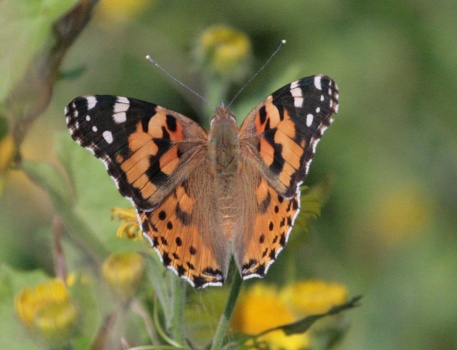
Tony showed me a photo
that he had taken while on holiday in Poland of a
large copse of dead trees on an island in which were
roosting thousands of Cormorants. I have seen
Cormorants roosting on the islands at Chichester
Gravel Pits but certainly not in these numbers.
WEDNESDAY
AUGUST 15 - 2018
Wall
Brown at Nore Barn
Brian Lawrence
struck gold during a walk around Nore Barn yesterday
with this stunning Wall Brown butterfly, sunning
itself in typical fashion. They are said to be
notoriously difficult to photograph, so well done on
this one, Brian.
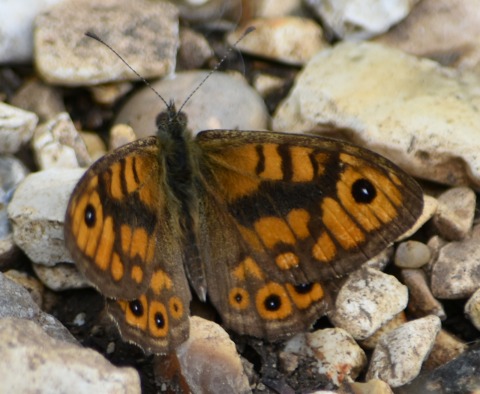
It is referred to
simplly as 'Wall' in some butterfly guides. Although
apparently quite widespread the Wall Brown is a rare
butterfly in this area. It is the first for this blog.
Brian has never seen one before, neither have I. I
have suggested Brian report the sighting to Butterfly
Conservation . . . . http://hantsiow-butterflies.org.uk/news_form.php
Warblington
to Emsworth
Peter
Milinets-Raby wandered around Warblington and Emsworth
this lunchtime ahead of an incoming tide. The
highlights were as follows.
Warblington shore off Pook Lane (11:30am to
12:10pm).
15 Common Gulls. 127 Redshank (-//B + B//GY - not seen
this bird before?). 2 Grey Plover in summer plumage. 3
Greenshank (G//R + YN//- & G//R + BR//- usual
regular). 1 Whimbrel. 2 Black tailed Godwit. 6 Common
Tern. 27 Dunlin. 24 Ringed Plover.
41 Little Egret on Langstone Mill Pond & 64
Mallard.
1 Shelduck off Conigar Point.
Beacon Square (from 12:18pm - finished at 1:40pm when
tide pushing in.)
17 Black tailed Godwit. 3 Grey Plover. 4 Greenshank
(G//R + BB//- & YO//- + YY//- & G//R + LG//-
). 8 female type eclipse Teal. 1 very tame Juvenile
Green Woodpecker in a back garden (see photo taken on
mobile phone ).
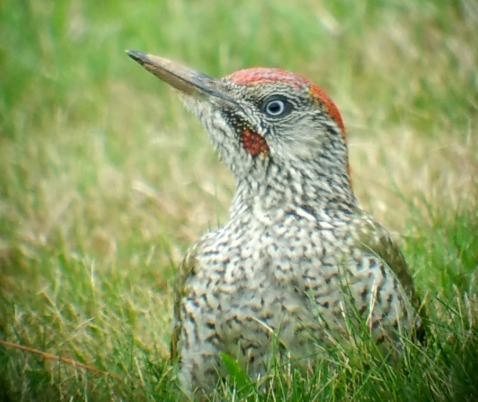
Nore Barn : A further
4 Greenshank. 1 Whimbrel. 2 Shelduck. 7 Mute Swan.
Emsworth Harbour : Another 6 Greenshank. 15 Black
tailed Godwit. 1 Turnstone. 5 Common Tern. 2 Grey
Plover.
Nice to see so many Greenshank.
MONDAY
AUGUST 13 - 2018
Bridge
Rd Wayside cutting
The wayside
adjacent to Bridge Road car park received its annual
cut today, thanks to Graham Palmer, the Assistant
Manager Open Spaces at Norse South East for organising
it. George, the Norse worker, arrived on site in his
truck at about 8am and I was there to greet him and
explain what needed to be done.
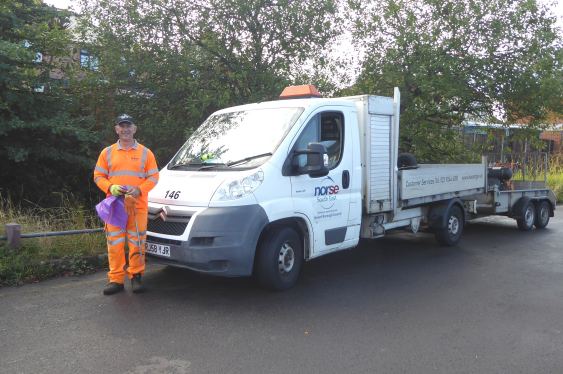
George was very
friendly and willing to carry out my instructions. The
first thing he did was a litter pick. I had already
filled 2 bags of litter from the wayside yesterday,
but he even found more. Later I filled yet another bag
and there is still more revealed by the cutting!
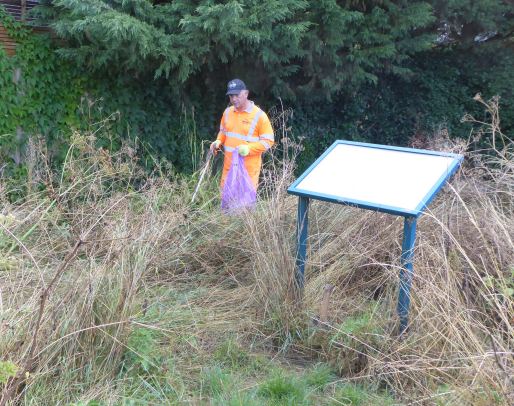
George also removed
the large pieces of furniture that had been fly-tipped
onto the wayside. This was heavy work!

Next George trimmed
back the overhanging brambles and other shrubs in the
central area to enable easier access to the narrow
area by the rails for the mower.
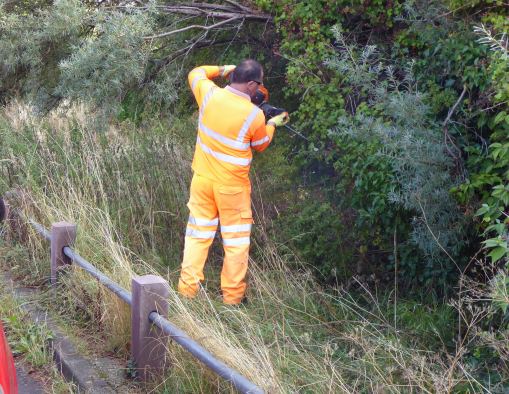
Here is a short video
clip of the trimming work . . . . https://youtu.be/4ggXWZf-Ng0
He left the Elder
rich with lovely display of red berries.
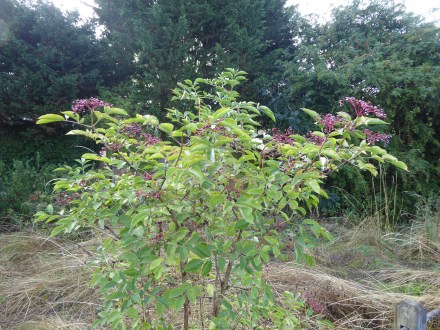
George then got the
large mower out of the truck to cut the main
grassland. It was hard going as the grasses were 5 ft
tall in places, but George managed to cut them down,
taking great care not to allow the cuttings to get
into the stream.

Video clip of the
mowing . . . https://youtu.be/yt9JPUX91Xs
Finally George tidied
up all around the wayside using the strimmer. He also
trimmed the main Beech hedge on the outside. This is a
valuable job as Brambles and other things were growing
out of the hedge partly blocking the footpath.

What an excellent job,
so many thanks to George and Graham.
A great day's work.
Here is the wayside before the cut . . .
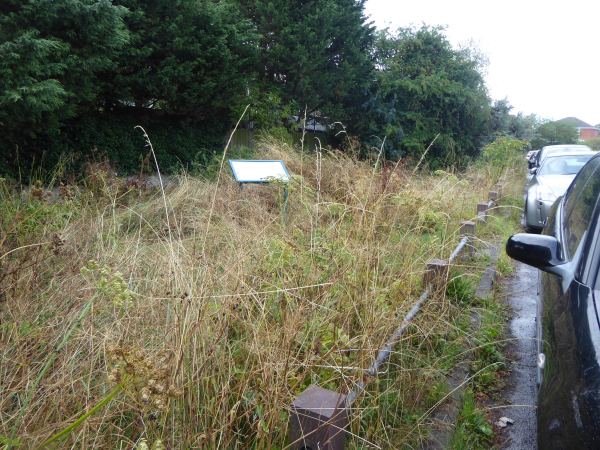
and here is the
wayside after the cut.
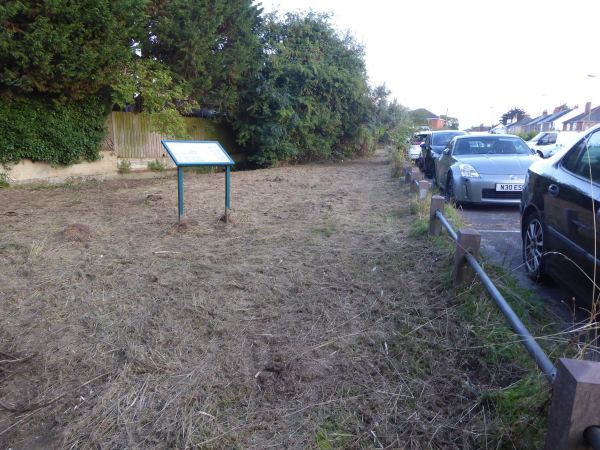
What is needed now is
to rake up and remove the arisings so that the
nutrients do not go back into the ground. A job for
the Neighbourhood Watch maybe?
Cuban
Vultures
Malcolm
Phillips, once such a familiar sight roaming the
glades of Brook Meadow with his long-lensed camera,
now lives in eastern Cuba with a new wife, house and,
of course, camera at the ready. Malcolm gets lots of
interesting birds in his garden and flying overhead,
including Turkish Vultures which have red heads.
However, today he had one with a black head which
asked me to identify as he is not able to get all the
internet sites in Cuba.
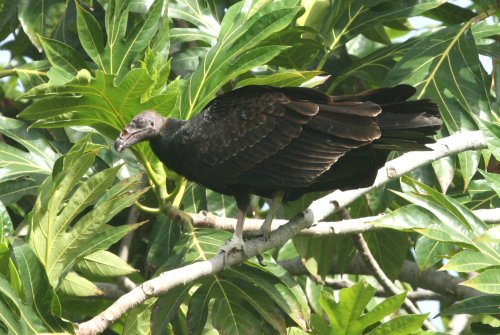
From the Birds of
North America web site I gather there are two types of
vultures seen in Cuba, the ever expanding Turkey
Vulture which has a red head. This bird is seen right
across the USA and farther north into Canada every
year. Then there is the Black Vulture which has a
black head. It lives in the south-eastern states and
into Mexico and out into the Caribbean islands. The
Turkey Vulture is able to find carrion with its eye
sight or with its sense of smell, unlike the Black
Vulture who is able to find its food only visually.
See ... https://www.birds-of-north-america.net/vultures_1.html
TUESDAY
AUGUST 7 - 2018
Langstone
Mill Pond
Peter
Milinets-Raby visited the Langstone Mill Pond this
afternoon just as the clouds moved in 1:57pm to 3pm -
low tide.
On the mud were plenty of Black-headed Gulls loafing
(150+). Amongst them were 10 Common Gulls and one
juvenile Med Gull (See photo - This is only the third
sighting of a juvenile I have had - Have Med Gulls had
a poor breeding season?
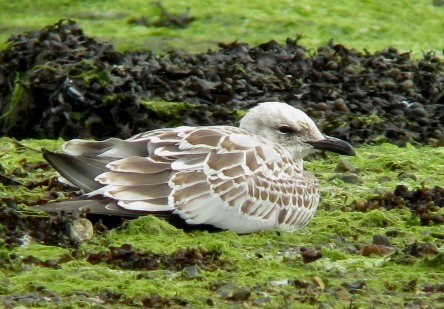
Also on the mud were:
106+ Redshank (-//B + B//LN (last seen in October
2014) & -//B + B//YO - Last seen Sept 2016). 27
Dunlin - most still with black bellies. 6 Greenshank
(G//R + BR//- - local favourite, feeds in the pond
outflow stream). 137 Black-tailed Godwits - 80% still
in summer plumage. 4 Grey Plover - all in summer
plumage. 2 Common Tern.
On the Pond: A full summer Little Grebe. 5 Little
Egrets. 9 Swallow over. 5 Swifts over heading south.
MONDAY
AUGUST 6 - 2018
Kookaburra
returns
Selena Gaunt
sent me two photos of what is clearly a Kookaburra
that she saw on Brook Meadow over the past week.
In fact, we have had
two previous sightings of a Blue-winged Kookaburra on
the meadow in early July (July 4 and 5), but none
since. It seems unlikely that there are two
Kookaburras on the loose in Emsworth, but the bird in
Selena's photos looks different from the earlier one,
less colourful and generally more scruffy. Here is the
more colourful one taken by Marion Emberson in
July.
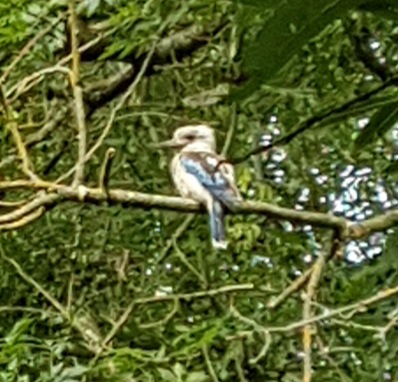
The Kookaburra is, of
course a bird Native to Australia, so will be an
escapee from a collection somewhere. Apparently, they
are quite valuable birds - costing up to £500 to
buy, so the owner would like it back, no doubt.
Terrapin
on Peter Pond
Nick Robinson
had quite a surprise yesterday when he saw a Terrapin
disappearing into the reeds on the west side of Peter
Pond. Discarded pet Terrapins do occasionally turn up
in urban ponds. I have seen them on Baffins Pond and
Petersfield Lake, but this was a first for Emsworth.
Although not unattractive, their presence in local
ponds and wetlands is generally not welcome as they
can be serious predators of native wildlife, including
fish, eggs and nestlings. I will inform David Gattrell
who manages Peter Pond of Nick's sighting. I would be
grateful for any further sightings with photos if
possible.
Here is a photo
of one taken by Mike Wells on Petersfield Lake a
couple of years ago.
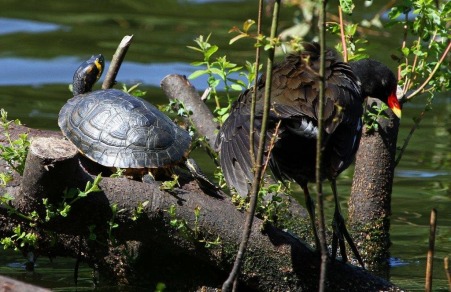
My
observations
Later this
morning I went looking for these two unusual
creatures. Very hot weather!
There was no sign of the Terrapin on Peter Pond, but
there are plenty of reeds for it to hide away in. I
thought it might like to rest on the raft in the sun,
but the Grey Heron was ruling the roost there.
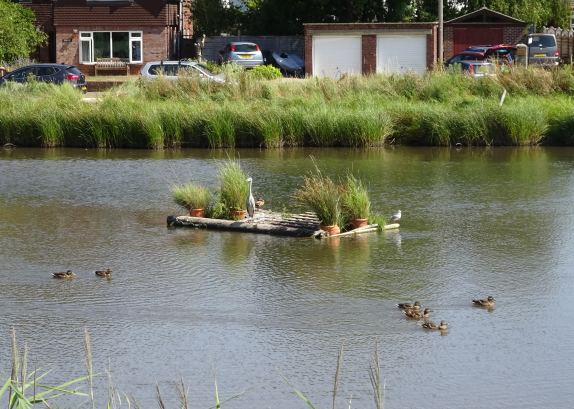
Over on Slipper
Millpond there was a flock of around 20 Canada Geese,
mostly on the rafts, with a few on the water.

There is a nice
showing of Golden Samphire on the inside of the
Hermitage bridge.
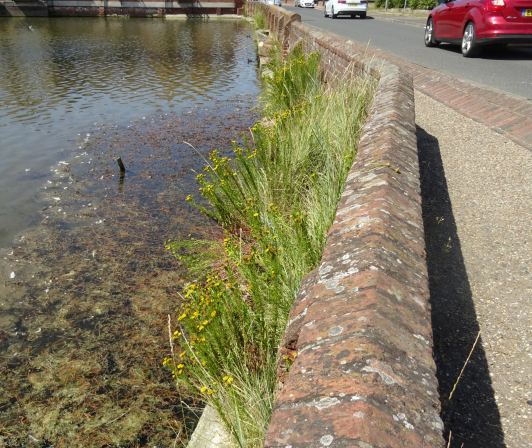
I sat for some while
in the shade on the seat on Brook Meadow where the
Kookaburra had been previously seen but there was no
sign of it.
Walking back along the riverside path through Palmer's
Road Copse I spotted a substantial hole in the east
bank of the river. It looked a bit large for a Water
Vole burrow, but you never know!
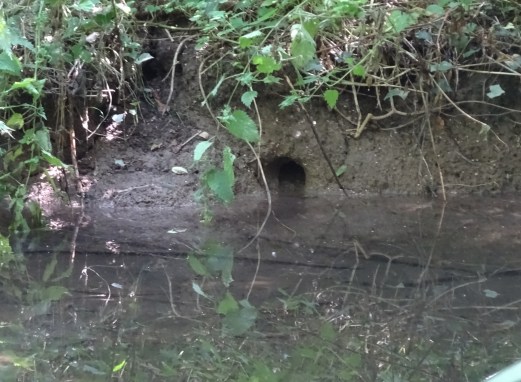
SUNDAY
AUGUST 5 - 2018
Brook
Meadow - Work session
Over to the
meadow this morning for the work session. Very hot.
Only 6 volunteers turned up. Unfortunately, Maurice
Lillie will not be able to attend work sessions for a
little while on medical advice following an
anaphylactic reaction to a wasp sting.
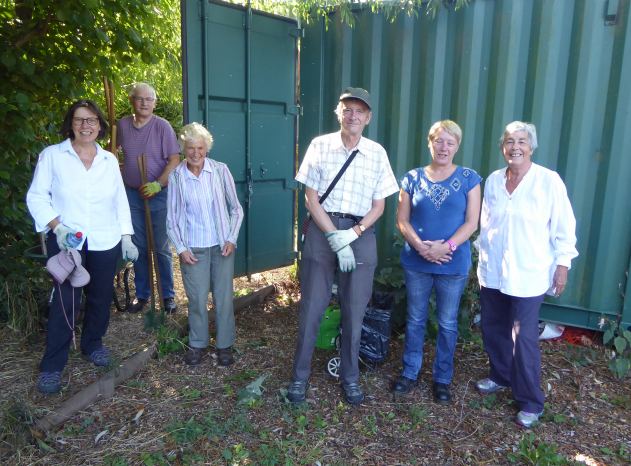
Jennifer Rye, leading,
sensibly decided to end the work session early. They
finished clearing the arisings from the orchid area
which had been cut in the previous session.

Video clip of the work
. . . . https://youtu.be/zfsEp-T5FM4
They also made a path
down to Frank's seat from the main river
path.
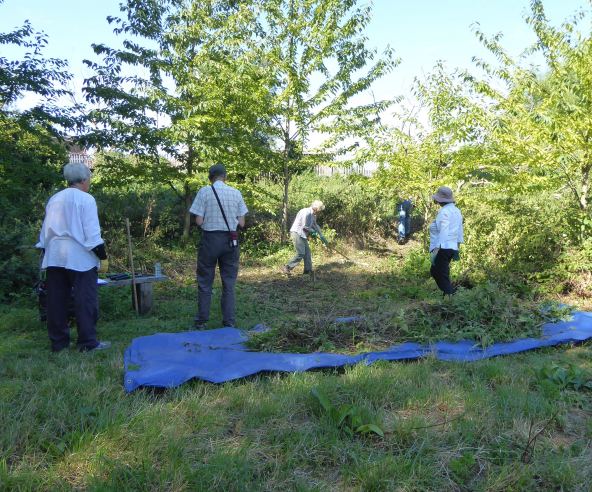
My
wildlife observations
Lots of
insects were feeding on the late flowering plants,
particularly on Hogweed. Here are a couple of
hoverflies I managed to snap which I think are
Volucella inanis and Myathropa
florea.
I was surprised to see
this Speckled Wood butterfly
feeding on the flowers of Hoary Ragwort which I do not
recall having seen before.

Finally, my first male
Common Darter of the year on Brook Meadow
resting on vegetation near the Lumley Stream, the
first of many no doubt.
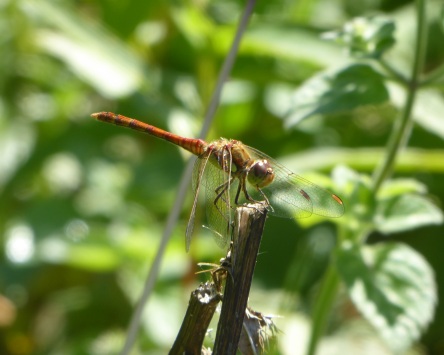
Warblington
shore
Peter
Milinets-Raby visited the Warblington shore yesterday
morning as the tide dropped from 6:48am to 8:32am. A
nice selection of waders.
Ibis Field: Male & female Pheasant, Reed Warbler
in west hedge and another half singing one in east
hedge (such scary birds when seen in hedges!!!). 2
Whitethroat, 1 Jay.
Hedgerow behind Conigar Point: 1 Spotted Flycatcher
- good record, one more Reed Warbler, 1 Jay.
Conigar Point: 4 Common Tern, 1 Ringed Plover, Adult
Great Black-backed Gull with begging juvenile -
probably the Slipper Pond birds. 2 Lesser Black-backed
Gull adults with 2 juvs.
Off Pook Lane: 6 Grey Plover - still in summer plumage
(nice). 127 Black-tailed Godwit (most still in summer
plumage). 6 Greenshank - RG//- + YY/-. 72+ Redshank -
nice to see them back. 2 Ringed Plover.
Warblington cemetery: 1 juvenile Green Woodpecker.
Forestside
Steph Dale
reported on Saturday walk by the Havant Wildlife
Group.
See report and photo at . . . http://familyfellows.com/hwg-walk-reports-2018.htm
For
the previous entries go to . . . July
17-31